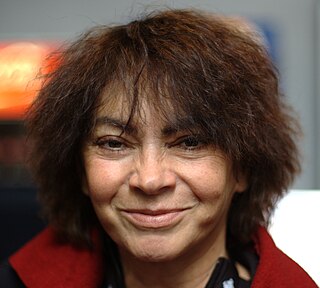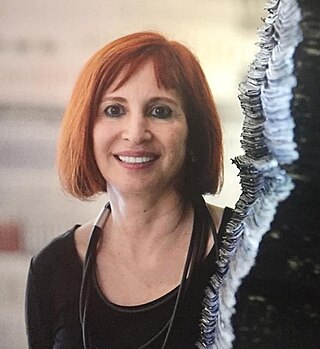
The Lebanese Civil War was a multifaceted armed conflict that took place from 1975 to 1990. It resulted in an estimated 120,000 fatalities and an exodus of almost one million people from Lebanon.

Elias Khoury is a Lebanese novelist and public intellectual. His novels and literary criticism have been translated into several languages. In 2000, he won the Prize of Palestine for his book Gate of the Sun, and he won the Al Owais Award for fiction writing in 2007. Khoury has also written three plays and two screenplays.

The Rashidieh camp is the second most populous Palestinian refugee camp in Lebanon, located on the Mediterranean coast about five kilometres south of the city of Tyre (Sur).

The cinema of Lebanon, according to film critic and historian Roy Armes, is the only other cinema in the Arabic-speaking region, beside Egypt's, that could amount to a national cinema. Cinema in Lebanon has been in existence since the 1920s, and the country has produced more than 500 films.

Jocelyne Saab was a Lebanese journalist and film director. She is recognized as one of the pioneers of Lebanese cinema. A reporter, photographer, scriptwriter, producer, director, artist and founder of the Cultural Resistance International Film Festival of Lebanon, Saab focused on the deprived and disadvantaged – from displaced peoples to exiled fighters, cities at war and a Fourth World without a voice. Her work is grounded in historic violence, and in an awareness of the actions and images required to document, reflect on and counteract it.

Walid Raad (Ra'ad) (Arabic: وليد رعد) (born 1967 in Chbanieh, Lebanon) is a contemporary media artist. The Atlas Group is a fictional collective, the work of which is produced by Walid Raad. He lives and works in New York, where he is currently a professor at the School of Art at the Cooper Union School of Art.

Bayt Beirut is a project of a museum and urban cultural center that is meant to portray the history of Beirut, with a particular focus on the Lebanese civil war. This project is located in the restored Barakat building, also known as the "Yellow house", a historic landmark designed by Youssef Aftimus.
Beirut Art Center is a space for exhibiting contemporary art in Beirut, Lebanon
Ashkal Alwan, The Lebanese Association for Plastic Arts is a non-profit organization that promotes contemporary art practices in Lebanon and the broader region.
Lamia Joreige is a Lebanese visual artist and filmmaker. She received a BFA from Rhode Island School of Design, Providence, Rhode Island. Since the late 1990s, her works have been widely displayed. She is a co founder and co director of the Beirut Art Center. In 2011, Sandra Dagher and Lamia Joreige organized “Museum as Hub: Beirut Art Center” at New York City's New Museum.
Saleh Barakat is a Lebanese art expert, gallery owner and curator. He studied at the American University of Beirut and was nominated as a Yale World Fellow in 2006. He runs Agial Art Gallery and Saleh Barakat Gallery in the Ras Beirut area.
Sandra Dagher is a Lebanese curator. Considered as an “art activist”, she currently is the advisor and head of programs of the Saradar Collection.

The siege of Beirut took place in summer 1982, as part of the 1982 Lebanon War, which resulted from the breakdown of the ceasefire effected by the United Nations. The siege ended with the Palestinian Liberation Organization being forced out of Beirut and the rest of Lebanon.
Johnny Alam is a Canadian researcher, visual artist, and curator. His art and research revolve around questions of memory, technology and representation with a special interest in photography, history and war.

Nayla Tamraz is a Lebanese writer, art critic, curator, researcher and professor of Literature and Art History at Saint Joseph University of Beirut. She obtained her PhD in Comparative Literature from the New Sorbonne University in 2004.

Joana Hadjithomas and Khalil Joreige are Lebanese filmmakers and artists. Their work includes feature and documentary films, video and photographic installations, sculpture, performance lectures and texts.

Nada Sehnaoui is a visual artist and political activist. Her artworks, spanning painting, mixed media works, sculpture and installations, have been widely exhibited internationally, and have been featured in the press and print publications worldwide.

Jayce Salloum is a Canadian multidisciplinary artist.
Rasha Salti is a researcher, writer, producer, and curator of art and film. She lives and works between Beirut and Berlin. Salti co-curated many film programs at public institutions, including ArteEast, Lincoln Center and Museum of Modern Art in New York, and collaborated with film festivals as a programmer, such as the Abu Dhabi International Film Festival and Toronto International Film Festival. Since 2017, she is the commissioning editor for La Lucarne at ArteFrance, a program dedicated to Auteur documentaries. Her curatorial projects were exhibited at numerous international public institutions, including Barcelona Museum of Contemporary Art, Haus der Kulturen der Welt in Berlin, Museo de la Solidaridad Salvador Allende in Santiago de Chile, the Sursock Museum in Beirut.

Memory Box is a Canadian-Lebanese-French drama film written and directed by Joana Hadjithomas and Khalil Joreige. The film stars Rim Turki, Manal Issa and Paloma Vauthier.












